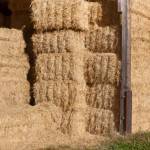Researchers Take a Closer Look at Teff

Teff hay is a warm-season grass that thrives in a variety of climates and soil types. Despite low resistance to frost and pests, researchers have recently tested teff to see how the grass stacks up against cool-season standbys, timothy and orchardgrass.
Using mature Quarter Horse mares, researchers at Pennsylvania State University evaluated the nutrient composition, voluntary dry matter intake (DMI), and apparent digestibility of teff hay cut at three different stages of maturity to determine its usefulness as hay. The hay was harvested at the boot, early-head, and late-head stages of maturity throughout the summer.
Nutrient composition revealed nonstructural carbohydrates (NSC) increased from 5.4% in the boot stage to 8.4% in the late-head stage, while concentrations of crude protein, potassium, iron, and manganese decreased. The calcium-to-phosphorus ratio was approximately 2:1 for all maturities. According to the researchers, the nutrient content of the boot and early-head maturities was sufficient to nearly meet (90-95%) average energy requirements.
Horses consumed boot and early-head maturities more readily than the most mature cutting. Based on these findings, teff hay might be a wise choice for overweight or metabolically challenged horses.
As with all dietary changes, seek professional advice from a qualified equine nutritionist before adding teff to a horse’s ration.
The complete article, “Voluntary intake and digestibility of teff hay fed to horses,” was published in the June 2010 edition of the Journal of Animal Science.








